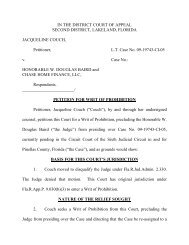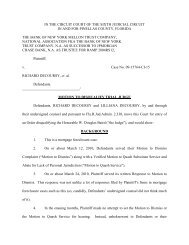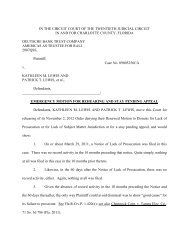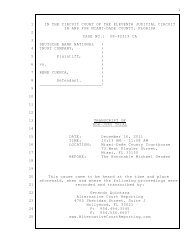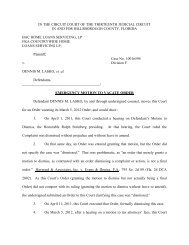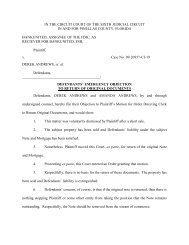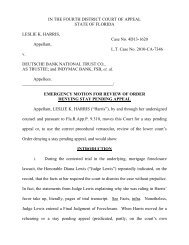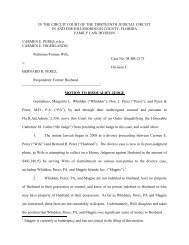Denial of Motion to DQ â Cert Petition - Stopa Law Firm
Denial of Motion to DQ â Cert Petition - Stopa Law Firm
Denial of Motion to DQ â Cert Petition - Stopa Law Firm
Create successful ePaper yourself
Turn your PDF publications into a flip-book with our unique Google optimized e-Paper software.
MARCUS FRANKLIN and<br />
MELISSA FRANKLIN,<br />
IN THE DISTRICT COURT OF APPEAL<br />
SECOND DISTRICT, LAKELAND, FLORIDA<br />
<strong>Petition</strong>ers,<br />
L.T. Case No. 2009-CA-25963<br />
v. Case No.: 2D10-<br />
THE BANK OF NEW YORK MELLON f/k/a<br />
The Bank <strong>of</strong> New York, as Successor <strong>to</strong> JPMorgan<br />
Chase Bank, N.A., as Trustee for the Benefit <strong>of</strong> the<br />
<strong>Cert</strong>ificateholders <strong>of</strong> Popular ABS, Inc. Mortgage<br />
Pass-Through <strong>Cert</strong>ificates Series 2005-5, Mortgage<br />
Electronic Registration Systems, Inc., as Nominee<br />
For Unimortgage, LLC,<br />
Respondents.<br />
________________________/<br />
PETITION FOR WRIT OF CERTIORARI<br />
<strong>Petition</strong>ers, MARCUS FRANKLIN and MELISSA FRANKLIN, by and<br />
through their undersigned counsel, petition this Court for a Writ <strong>of</strong> <strong>Cert</strong>iorari, <strong>to</strong><br />
quash an Order denying their <strong>Motion</strong> <strong>to</strong> Disqualify Counsel, and as grounds would<br />
show:<br />
BASIS FOR THIS COURT’S JURISDICTION<br />
1. <strong>Petition</strong>ers moved <strong>to</strong> disqualify Brandon Mullis, Esquire (“Mullis”),<br />
and the law firm <strong>of</strong> Shapiro & Fishman, LLP (collectively “Shapiro”) from<br />
representing Respondent, THE BANK OF NEW YORK MELLON f/k/a The Bank<br />
<strong>of</strong> New York, as Successor <strong>to</strong> JPMorgan Chase Bank, N.A., as Trustee for the
Benefit <strong>of</strong> the <strong>Cert</strong>ificateholders <strong>of</strong> Popular ABS, Inc. Mortgage Pass-Through<br />
<strong>Cert</strong>ificates Series 2005-5 (“the Bank”). This Court has original jurisdiction under<br />
Fla.R.App.P. 9.030(b)(2) <strong>to</strong> enter a Writ <strong>of</strong> <strong>Cert</strong>iorari.<br />
NATURE OF THE RELIEF SOUGHT<br />
2. <strong>Petition</strong>er seeks a Writ <strong>of</strong> <strong>Cert</strong>iorari from this Court, quashing an<br />
Order <strong>of</strong> the lower court denying the <strong>Motion</strong> <strong>to</strong> Disqualify Counsel (“<strong>Motion</strong> <strong>to</strong><br />
Disqualify”), and directing the lower court <strong>to</strong> enter an order <strong>of</strong> disqualification <strong>of</strong><br />
Shapiro as counsel for the Bank.<br />
3. Alternatively, <strong>Petition</strong>er seeks a remand for an evidentiary hearing on<br />
the disputed factual issues set forth in the <strong>Motion</strong> <strong>to</strong> Disqualify.<br />
FACTS: BACKGROUND<br />
4. On Oc<strong>to</strong>ber 12, 2009, the Bank initiated the lower court case, through<br />
its counsel, Shapiro, by filing suit against <strong>Petition</strong>ers as well as Nominal<br />
Respondent, Mortgage Electronic Registration Systems, Inc. (“MERS”), as<br />
Nominee for Unimortgage, LLC (“Unimortgage”). In the Complaint, the Bank<br />
seeks foreclosure <strong>of</strong> a mortgage; a copy <strong>of</strong> the Note and Mortgage are attached<br />
there<strong>to</strong>.<br />
See Appendix <strong>to</strong> <strong>Petition</strong>, 1.<br />
5. The Note was entered on behalf <strong>of</strong> Unimortgage, not the Bank.<br />
See<br />
Appendix <strong>to</strong> <strong>Petition</strong>, 1, Exhibit “A.” The Mortgage was entered on behalf <strong>of</strong><br />
MERS, as Nominee for Unimortgage, not the Bank. See Appendix <strong>to</strong> <strong>Petition</strong>, 1,<br />
2
Exhibit “A.” As such, it is axiomatic that the Bank’s standing <strong>to</strong> prosecute this<br />
lawsuit is predicated on some type <strong>of</strong> transfer <strong>of</strong> the Note and Mortgage from<br />
Unimortgage and/or MERS <strong>to</strong> the Bank. See Appendix <strong>to</strong> <strong>Petition</strong>, 1, 7 (“Prior<br />
<strong>to</strong> the filing <strong>of</strong> this action, Plaintiff acquired the right <strong>to</strong> enforce the Note and<br />
Mortgage from the party entitled <strong>to</strong> enforce the Note and Mortgage.”).<br />
Significantly, nowhere in the Complaint did the Bank clarify how it had acquired<br />
the right <strong>to</strong> enforce the Note and Mortgage, i.e. whether there was a valid<br />
assignment, pro<strong>of</strong> <strong>of</strong> purchase <strong>of</strong> the debt, or some other form <strong>of</strong> transfer. See<br />
Appendix <strong>to</strong> <strong>Petition</strong>, 1.<br />
6. After MERS did not respond <strong>to</strong> the Complaint, the Bank sought and<br />
obtained entry <strong>of</strong> a clerk’s default against it.<br />
See Appendix <strong>to</strong> <strong>Petition</strong>, 2. The<br />
Bank’s <strong>Motion</strong> for Default against MERS was executed by Shapiro, and the<br />
Affidavit <strong>of</strong> Service attached there<strong>to</strong> reflects that service was effectuated by a<br />
process server company called ProVest, LLC. See Appendix <strong>to</strong> <strong>Petition</strong>, 2.<br />
7. Respondents timely responded <strong>to</strong> the Complaint by way <strong>of</strong> <strong>Motion</strong> <strong>to</strong><br />
Dismiss, alleging the Bank failed <strong>to</strong> plead sufficient ultimate facts showing its<br />
ability <strong>to</strong> foreclose a Note and Mortgage in the name <strong>of</strong> MERS.<br />
See Appendix <strong>to</strong><br />
<strong>Petition</strong>, 3. Said motion has yet <strong>to</strong> be adjudicated, but the pendency <strong>of</strong> the motion<br />
reflects that the Bank’s standing, and its ability <strong>to</strong> prove a valid transfer <strong>of</strong> the Note<br />
and Mortgage, will be significant issues as the case is litigated.<br />
3
8. In the process <strong>of</strong> preparing said motion, <strong>Petition</strong>ers encountered an<br />
Assignment <strong>of</strong> Mortgage in the Official Records <strong>of</strong> Hillsborough County, Florida<br />
(“the Assignment”), which assignment purports <strong>to</strong> convey the Mortgage from<br />
MERS <strong>to</strong> the Bank. <strong>Petition</strong>ers then filed their <strong>Motion</strong> <strong>to</strong> Disqualify, with the<br />
Assignment <strong>of</strong> Mortgage attached there<strong>to</strong>. See Appendix <strong>to</strong> <strong>Petition</strong>, 4. Consistent<br />
with Florida procedure, <strong>Petition</strong>ers signed the <strong>Motion</strong> <strong>to</strong> Disqualify under oath.<br />
See Appendix <strong>to</strong> <strong>Petition</strong>, 4.<br />
9. In the <strong>Motion</strong> <strong>to</strong> Disqualify, <strong>Petition</strong>ers showed:<br />
a. <strong>Petition</strong>ers never signed a Note and Mortgage with the Bank, so<br />
the Bank’s standing had <strong>to</strong> be predicated on some sort <strong>of</strong> assignment or<br />
transfer <strong>of</strong> the Note and Mortgage, apparently from MERS <strong>to</strong> the Bank;<br />
b. The Official Records <strong>of</strong> Hillsborough County, Florida, reflect<br />
an Assignment <strong>of</strong> Mortgage from MERS, as Nominee for Unimortgage, <strong>to</strong><br />
the Bank, executed on Oc<strong>to</strong>ber 12, 2009 (the same date the lawsuit was<br />
filed) and recorded on Oc<strong>to</strong>ber 19, 2009;<br />
c. The Assignment was “prepared by” and <strong>to</strong> be “returned <strong>to</strong>” the<br />
Bank’s counsel, Shapiro;<br />
d. Instead <strong>of</strong> identifying the address <strong>of</strong> MERS, the purported<br />
assignor, the Assignment lists Shapiro’s name and address in MERS’ place;<br />
e. The Notary block on the Assignment indicates the Assignment<br />
4
was executed in Harris County, Texas, which is where, as the Assignment<br />
reflects, the Bank conducts business, not MERS (which conducts business in<br />
Ocala, Florida); and<br />
f. The Assignment reflects it was executed by Marti Noriega,<br />
purportedly as Vice President <strong>of</strong> MERS, yet Marti Noriega is actually the<br />
Assistant Vice President <strong>of</strong> the Bank.<br />
See Appendix <strong>to</strong> <strong>Petition</strong>, 4.<br />
10. As <strong>Petition</strong>ers asserted in the <strong>Motion</strong> <strong>to</strong> Disqualify, these facts,<br />
viewed <strong>to</strong>gether, raise serious concerns. For instance, if the Assignment were a<br />
legitimate business transaction, and the Bank actually obtained the Assignment<br />
from MERS, as Nominee for Unimortgage, then why did Shapiro, the Bank’s<br />
counsel in this case, prepare the Assignment On or about the same day the<br />
lawsuit was filed Why was it signed and notarized in Texas, where the Bank<br />
conducts business, instead <strong>of</strong> Ocala, where MERS conducts business Why is<br />
Shapiro’s address listed in place <strong>of</strong> MERS’ address And why was it signed by<br />
Marti Noriega, an agent <strong>of</strong> the Bank, and not an agent <strong>of</strong> MERS<br />
See Appendix <strong>to</strong><br />
<strong>Petition</strong>, 4.<br />
11. The legitimacy <strong>of</strong> the Assignment is one significant concern; the<br />
conduct <strong>of</strong> Shapiro is another. For example, Shapiro is acting as counsel for the<br />
Bank against MERS, yet Shapiro currently represents MERS in other, pending<br />
5
cases, including Hillsborough County Case No. 2009-CA-6578. Perhaps worse<br />
yet, Shapiro is acting as counsel for the Bank against MERS even though Shapiro<br />
acted as counsel for MERS in this very dispute (with respect <strong>to</strong> the Assignment)!<br />
As <strong>Petition</strong>ers asserted in the <strong>Motion</strong> <strong>to</strong> Disqualify, there seems <strong>to</strong> be no other<br />
explanation for why Shapiro would prepare the Assignment, insert its name and<br />
address in place <strong>of</strong> MERS’ address on the Assignment, cause the Assignment <strong>to</strong> be<br />
executed on or about the date the lawsuit was filed, and cause one <strong>of</strong> the Bank’s<br />
agents <strong>to</strong> execute the Assignment (purportedly on behalf <strong>of</strong> MERS). See Appendix<br />
<strong>to</strong> <strong>Petition</strong>, 4.<br />
12. Based on these facts, <strong>Petition</strong>ers alleged, in the <strong>Motion</strong> <strong>to</strong> Disqualify,<br />
that Shapiro had a conflict <strong>of</strong> interest under Rule 4-1.7, R.Reg.Fla.Bar, requiring<br />
its disqualification as counsel. As a secondary basis for disqualification, <strong>Petition</strong>ers<br />
argued that Shapiro was not only a witness in the proceeding, but had become such<br />
a “central figure” in the lawsuit that its disqualification was required.<br />
See<br />
Appendix <strong>to</strong> <strong>Petition</strong>, 4. Finally, as a tertiary basis for disqualification, <strong>Petition</strong>ers<br />
contended that Shapiro’s disqualification was required under Rule 4.1-16(5),<br />
R.Reg.Fla.Bar, as the Bank had used Shapiro’s services <strong>to</strong> commit a crime or<br />
fraud.<br />
13. Shapiro filed a written Response <strong>to</strong> the <strong>Motion</strong> <strong>to</strong> Disqualify as well<br />
as a motion <strong>to</strong> strike it.<br />
See Appendix <strong>to</strong> <strong>Petition</strong>, 5 and 6, respectively.<br />
6
Essentially, Shapiro argued that the <strong>Motion</strong> <strong>to</strong> Disqualify was legally insufficient.<br />
Also, Shapiro argued, for the first time, that the Bank was not relying on the<br />
Assignment as the basis for its standing (and that the legitimacy <strong>of</strong> the Assignment<br />
was hence a moot issue).<br />
14. Meanwhile, a one-hour hearing on the <strong>Motion</strong> <strong>to</strong> Disqualify was<br />
scheduled for May 27, 2010 at 8:00 a.m.<br />
15. On February 16, 2010, attempting <strong>to</strong> flesh out the facts, <strong>to</strong> the extent<br />
they were in dispute (both in the case in general and with respect <strong>to</strong> the <strong>Motion</strong> <strong>to</strong><br />
Disqualify), <strong>Petition</strong>ers served their First Set <strong>of</strong> Interroga<strong>to</strong>ries and First Request<br />
for Production. See Appendix <strong>to</strong> <strong>Petition</strong>, 7 and 8, respectively. Additionally,<br />
<strong>Petition</strong>ers filed a Subpoena Duces Tecum on Mullis, requiring his attendance at<br />
the May 27 hearing, as well as a Request for Judicial Notice. See<br />
Appendix <strong>to</strong><br />
<strong>Petition</strong>, 9 and 10, respectively.<br />
16. The subpoena on Mullis was intended <strong>to</strong> obtain his testimony on<br />
issues pertinent <strong>to</strong> the <strong>Motion</strong> <strong>to</strong> Disqualify Counsel, particularly <strong>to</strong> the extent<br />
Shapiro was disagreeing with the facts set forth in the motion. For instance, the<br />
subpoena required production <strong>of</strong> fee agreements between Shapiro and MERS,<br />
which would clarify any at<strong>to</strong>rney-client relationship between Shapiro and MERS.<br />
Also, Mullis’ testimony would shed light on whether ProVest, LLC (the process<br />
server that served MERS) was actually an in-house process server for Shapiro.<br />
7
17. Unfortunately, and despite the fact that the <strong>Motion</strong> <strong>to</strong> Disqualify was<br />
evidentiary in nature, <strong>Petition</strong>ers’ attempts <strong>to</strong> obtain evidence or discovery were<br />
met with nothing but opposition. On February 23, 2010, the Bank moved for an<br />
extension <strong>of</strong> time <strong>to</strong> respond <strong>to</strong> the discovery, then never responded, necessitating<br />
a <strong>Motion</strong> <strong>to</strong> Compel. See Appendix <strong>to</strong> <strong>Petition</strong> 11 and 12, respectively.<br />
18. Incredibly, despite not responding <strong>to</strong> this discovery, Shapiro argued<br />
<strong>Petition</strong>ers had never sought discovery (which, <strong>of</strong> course, was plainly false), then<br />
used the absence <strong>of</strong> any such discovery in support <strong>of</strong> their position that there was<br />
no evidence “in the record” <strong>to</strong> support disqualification.<br />
1 See Appendix <strong>to</strong> <strong>Petition</strong>,<br />
5 and 6.<br />
19. On the afternoon <strong>of</strong> May 25, 2010, less than two days before the<br />
scheduled hearing, Shapiro filed a <strong>Motion</strong> <strong>to</strong> Quash the Subpoena Duces Tecum <strong>of</strong><br />
Mullis and attempted <strong>to</strong> set that motion for hearing.<br />
See Appendix <strong>to</strong> <strong>Petition</strong>, 13.<br />
Despite the undersigned’s unavailability, Shapiro noticed the hearing for the<br />
following day, May 26, 2010 at 11:00 a.m.<br />
20. Candidly, the undersigned believed that the hearing would not<br />
proceed, given the incredibly short notice, his unavailability, and the lack <strong>of</strong> any<br />
1 Oddly, Shapiro seemed <strong>to</strong> believe that evidence supporting disqualification had <strong>to</strong><br />
be fleshed out in discovery and that the presentation <strong>of</strong> evidence at the dulynoticed,<br />
evidentiary hearing was not permitted. Suffice it <strong>to</strong> say that this position<br />
was non-sensical and contrary <strong>to</strong> law. See analysis, infra.<br />
8
emergency. After all, even if, arguendo, the subpoena were somehow improper,<br />
there was nothing s<strong>to</strong>pping the lower court from quashing it at the start <strong>of</strong> the<br />
hearing on May 27, 2010 (before Mullis’ testimony and before anything<br />
objectionable was produced). Nonetheless, on May 26, 2010 at approximately<br />
11:05 a.m., as the undersigned was in chambers for a different hearing, in a<br />
different case, in a different county, the lower court telephoned that judge’s<br />
chambers and, over objection, ordered the undersigned <strong>to</strong> argue the hearing via<br />
phone. 2<br />
See Appendix <strong>to</strong> <strong>Petition</strong>, 14. The lower court then quashed the subpoena<br />
<strong>of</strong> Mullis, ruling “If Judge Levens thinks that testimony is necessary, then he can<br />
have that taken or have the hearing continued for that testimony at a later time.”<br />
See Appendix <strong>to</strong> <strong>Petition</strong>, 14, p. 9. A written Order quashing the subpoena ensued.<br />
See Appendix <strong>to</strong> <strong>Petition</strong>, 15.<br />
21. On May 27, 2010, the lower court conducted a hearing on the <strong>Motion</strong><br />
<strong>to</strong> Disqualify Counsel. The motion was verified, but except for the facts verified in<br />
the motion, neither side presented any evidence.<br />
See Appendix <strong>to</strong> <strong>Petition</strong>, 16. Of<br />
course, <strong>Petition</strong>ers had been precluded from presenting evidence, by way <strong>of</strong><br />
testimony and documentation from Mullis, because the court had quashed the<br />
subpoena. See Appendix <strong>to</strong> <strong>Petition</strong>, 14, 15.<br />
2 The judge presiding over that hearing, Judge Pendino, was not even the judge<br />
presiding over the case. See Appendix <strong>to</strong> <strong>Petition</strong>, 16.<br />
9
22. The Bank presented absolutely no evidence <strong>to</strong> contradict the sworn<br />
assertions in the <strong>Motion</strong> <strong>to</strong> Disqualify Counsel, either at the hearing or otherwise.<br />
See Appendix <strong>to</strong> <strong>Petition</strong>, 16. Oddly, even though the hearing had been set for an<br />
hour, at the Court’s instruction, and the Court <strong>to</strong>ld the Bank beforehand “that we<br />
needed <strong>to</strong> have an evidentiary hearing,” Appendix <strong>to</strong> <strong>Petition</strong>, 16, p. 30, the Bank<br />
<strong>to</strong>ok the position that “we were never advised by the Court that we needed <strong>to</strong> have<br />
testimony.” 3<br />
See Appendix <strong>to</strong> <strong>Petition</strong>, 16, p. 30. Hence, the Bank had no<br />
witnesses or other evidence <strong>to</strong> contravene the facts set forth in the <strong>Motion</strong> <strong>to</strong><br />
Disqualify Counsel. See Appendix <strong>to</strong> <strong>Petition</strong>, 9.<br />
23. As the hearing proceeded, it became clear that Shapiro and the Bank<br />
wanted <strong>to</strong> deny the facts set forth in the <strong>Motion</strong> <strong>to</strong> Disqualify Counsel but had no<br />
evidentiary basis in which <strong>to</strong> do so.<br />
See<br />
Appendix <strong>to</strong> <strong>Petition</strong>, 16. As a result,<br />
instead <strong>of</strong> just presenting legal argument, Barbara Couture, Esquire (the at<strong>to</strong>rney<br />
who attended the hearing for the Bank), wound up making various factual<br />
assertions, contrary <strong>to</strong> those set forth in the <strong>Motion</strong> <strong>to</strong> Disqualify Counsel, without<br />
being under oath and without being subjected <strong>to</strong> cross-examination.<br />
24. For instance, after Ms. Couture argued that the Bank was not relying<br />
on the Assignment <strong>of</strong> Mortgage (upon which the <strong>Motion</strong> <strong>to</strong> Disqualify Counsel<br />
3 Shapiro did not explain how an evidentiary hearing could take place without<br />
testimony.<br />
10
was largely predicated), purportedly because the Bank’s standing was predicated<br />
on a transfer <strong>of</strong> the Note, the following exchange <strong>to</strong>ok place:<br />
The Court: When did the commercial transaction vest the ownership<br />
<strong>of</strong> the note <strong>to</strong> the plaintiff in this case<br />
Ms. Couture: 2005.<br />
Mr. S<strong>to</strong>pa: I feel like I have <strong>to</strong> object. Is she testifying<br />
The Court: Well, I am asking her not <strong>to</strong> testify. I am asking her what<br />
evidence – well, I guess I am looking ahead. I am trying <strong>to</strong> figure out<br />
where this is headed.<br />
Appendix <strong>to</strong> <strong>Petition</strong>, 16, pp. 35-36.<br />
25. As the hearing continued, the lower court seemed <strong>to</strong> grasp the issue,<br />
i.e. Shapiro’s conflict <strong>of</strong> interest under Rule 4-1.7 due <strong>to</strong> its simultaneous<br />
representation <strong>of</strong> the Bank and MERS, and asked:<br />
The Court: Let me focus you back on what, <strong>to</strong> me, was the lead issue<br />
raised in the <strong>Motion</strong> for Disqualification, and that is that you can’t<br />
have two masters, so <strong>to</strong> speak, or something <strong>to</strong> that effect. That is a<br />
simplification, but, basically, the idea <strong>of</strong> how you can represent both,<br />
the plaintiff and one <strong>of</strong> the defendants, in a foreclosure case.<br />
In response <strong>to</strong> that question, and throughout the rest <strong>of</strong> the hearing, Ms. Couture<br />
made numerous, unsworn factual assertions:<br />
Ms. Couture: We are not representing MERS. …<br />
Pro Vest is not an in-house – under any stretch, it is not an in-house<br />
company.<br />
Brandon Mullis does not prepare assignments <strong>of</strong> mortgage.<br />
11
Marti Noriega is not in-house. …<br />
There is no conflict <strong>of</strong> interest because, as I explained, MERS was<br />
merely added in her for the purpose <strong>of</strong> unclouding the title. …<br />
Mr. Mullis did not put this <strong>to</strong>gether, did not have anything <strong>to</strong> do with<br />
this. It was done in-house, it has a slash down there.<br />
Appendix <strong>to</strong> <strong>Petition</strong>, 16, pp. 36-41.<br />
26. Throughout the hearing, <strong>Petition</strong>ers objected <strong>to</strong> Shapiro’s repeated<br />
attempts <strong>to</strong> disagree with the facts set forth in the <strong>Motion</strong> <strong>to</strong> Disqualify Counsel<br />
without any evidence, merely by the unsworn assertions <strong>of</strong> counsel. To illustrate,<br />
in rebuttal, the undersigned argued:<br />
Where I thought that the argument really – <strong>of</strong> counsel really fell<br />
apart was when Your Honor asked the question <strong>of</strong> – you made the<br />
biblical reference, and counsel responded by saying “We are not<br />
representing MERS.” “We are not representing MERS.”<br />
That’s testimony. And then there was lots <strong>of</strong> other testimony<br />
after that. … That’s exactly why I subpoenaed Brandon Mullis <strong>to</strong><br />
come here. They can’t get away with statements like that. You can’t<br />
come in<strong>to</strong> court as a lawyer purporting <strong>to</strong> present testimony when you<br />
are not under oath and not giving me a chance <strong>to</strong> get documents.<br />
Appendix <strong>to</strong> <strong>Petition</strong>, 9, pp. 46-47. Then, when it appeared the lower court was<br />
going <strong>to</strong> rule on the <strong>Motion</strong> <strong>to</strong> Disqualify Counsel (without allowing testimony<br />
from Mullis or other evidence), <strong>Petition</strong>ers requested a continuance “<strong>to</strong> the extent<br />
Your Honor is relying on the unsworn statements <strong>of</strong> counsel.” Appendix <strong>to</strong><br />
<strong>Petition</strong>, 9, p. 52. The lower court then denied the <strong>Motion</strong> <strong>to</strong> Disqualify Counsel,<br />
as well as the continuance, without explanation. See Appendix <strong>to</strong> <strong>Petition</strong>, 16, pp.<br />
12
52-53. A written Order followed, see Appendix <strong>to</strong> <strong>Petition</strong>, 17, and this timely<br />
<strong>Petition</strong> ensued.<br />
provides:<br />
ARGUMENT<br />
27. Rule 4-1.7, R.Reg.Fla.Bar (Conflict <strong>of</strong> Interest, Current Clients),<br />
(a) Representing Adverse Interests. Except as provided in subdivision (b),<br />
a lawyer shall not represent a client if:<br />
1. the representation <strong>of</strong> 1 client will be directly adverse <strong>to</strong> another<br />
client; or<br />
2. there is a substantial risk that the representation <strong>of</strong> 1 or more<br />
clients will be materially limited by the lawyer’s responsibilities <strong>to</strong><br />
another client, a former client or a third person or by a personal<br />
interest <strong>of</strong> the lawyer.<br />
(b) Notwithstanding the existence <strong>of</strong> a conflict <strong>of</strong> interest under subdivision<br />
(a), a lawyer may represent a client if:<br />
1. The lawyer reasonably believes that the lawyer will be able <strong>to</strong><br />
provide competent and diligent representation <strong>to</strong> each affected<br />
client;<br />
2. The representation is not prohibited by law;<br />
3. The representation does not involve the assertion <strong>of</strong> a position<br />
adverse <strong>to</strong> another client when the lawyer represents both clients in<br />
the same proceeding before a tribunal; and<br />
4. Each affected client gives informed consent, confirmed in writing<br />
or clearly stated on the record at a hearing.<br />
28. In the present case, <strong>Petition</strong>ers showed that Shapiro represented the<br />
13
Bank (the plaintiff), adverse <strong>to</strong> MERS (the defendant), even though Shapiro<br />
represented MERS in other, pending cases (e.g. Hillsborough County Case No.<br />
2009-CA-6578). See Appendix <strong>to</strong> <strong>Petition</strong>, 4, pp. 4-5. In fact, <strong>Petition</strong>ers showed<br />
that Shapiro represented the Bank, adverse <strong>to</strong> MERS, even though Shapiro<br />
represented MERS vis a vis the Assignment <strong>of</strong> Mortgage at issue in this case. See<br />
Appendix <strong>to</strong> <strong>Petition</strong>, 4. On these facts, there can be no doubt that Shapiro’s<br />
representation <strong>of</strong> the Bank (the plaintiff) was “directly adverse” <strong>to</strong> MERS (the<br />
defendant) under 4-1.7(a)(1).<br />
29. Neither Shapiro nor the Bank made any attempt <strong>to</strong> satisfy the four<br />
subparts <strong>of</strong> subsection (b) <strong>of</strong> Rule 4-1.7. For instance, neither MERS nor the Bank<br />
gave informed consent, confirmed in writing or clearly stated on the record at a<br />
hearing.<br />
See Appendix <strong>to</strong> <strong>Petition</strong>, 16. As such, there was and is no way around<br />
the prohibition in Rule 4-1.7(a)(1). The conflict <strong>of</strong> interest is readily apparent,<br />
requiring disqualification. See HSBC Bank USA, N.A. v. Vasquez, 2009 N.Y.<br />
Slip Op. 51814 (N.Y. 2009) (“plaintiff’s counsel has <strong>to</strong> address the conflict <strong>of</strong><br />
interest that exists with his representation <strong>of</strong> both the assignor <strong>of</strong> the instant<br />
mortgage, MERS and nominee for HSBC Mortgage, and the assignee <strong>of</strong> the instant<br />
mortgage.”). 4<br />
4 There are no Florida cases on the conflict <strong>of</strong> interest that arises when the same<br />
law firm simultaneously represents multiple entities in foreclosure cases (mostly<br />
14
provides:<br />
30. Meanwhile, Rule 4-1.16 (Declining or Terminating Representation)<br />
(a) When <strong>Law</strong>yer Must Decline or Terminate Representation.<br />
… a lawyer shall not represent a client or, where representation has<br />
commenced, shall withdraw from the representation if:<br />
(5) the client has used the lawyer’s services <strong>to</strong> perpetrate a<br />
crime or fraud, unless the client agrees <strong>to</strong> disclose and<br />
rectify the crime or fraud.<br />
31. Here, the undisputed evidence showed the Bank used Shapiro’s<br />
services <strong>to</strong> prepare an Assignment <strong>of</strong> Mortgage, purportedly <strong>to</strong> assign a Mortgage<br />
from MERS, as Nominee for Unimortgage, <strong>to</strong> the Bank, but then caused its own<br />
employee, Marti Noriega, <strong>to</strong> execute that assignment on the same day the Bank<br />
filed suit (and record that assignment in the <strong>of</strong>ficial records just one week later).<br />
See Appendix <strong>to</strong> <strong>Petition</strong>, 4, 16. The fraudulent and self-dealing nature <strong>of</strong> this<br />
conduct is, respectfully, appalling. 5 See HSBC Bank USA, N.A. v. Vazquez, 2009<br />
N.Y. Slip Op. 51814 (N.Y. 2009); Bank <strong>of</strong> New York v. Mulligan, 2008 N.Y. Slip.<br />
Op 31501 (N.Y. 2008) (“The Court is concerned that Mr. Harless might be<br />
because this has just become an issue in recent years, after the real estate crash and<br />
the advent <strong>of</strong> MERS). The absence <strong>of</strong> such case law, coupled with the volume <strong>of</strong><br />
cases where this has become an issue, accentuates the need for a written opinion<br />
from this Court.<br />
5 It appears the Bank would have the court justify this self-dealing by arguing,<br />
without record evidence, that MERS authorized the Bank’s own employees,<br />
including Marti Noriega, <strong>to</strong> sign on its behalf. Even if that were true, however,<br />
where MERS is <strong>to</strong> sign as Nominee for Unimortgage, as in this case, and Mr.<br />
Noriega is acting on behalf <strong>of</strong> the Bank, not Unimortgage, the problem persists.<br />
15
engaged in a subterfuge, wearing various corporate hats. Before granting an<br />
application for an order <strong>of</strong> reference, the Court requires an affidavit from Mr.<br />
Harless describing his employment his<strong>to</strong>ry for the past three years.”); Bank <strong>of</strong> New<br />
York v. Orosco, 2007 N.Y. Slip Op 33818 (N.Y. 2007); Deutsche Bank Nat’l Trust<br />
Co. v. Castellanos, 2008 N.Y. Slip. Op. 50033 (N.Y. 2008) (“Did Mr. Rivas<br />
somehow change employers on July 21, 2006 or is he concurrently a Vice<br />
President <strong>of</strong> both assignor Argent Mortgage Company, LLC and assignee Deutsche<br />
Bank If he is a Vice President <strong>of</strong> both the assignor and the assignee, this would<br />
create a conflict <strong>of</strong> interest and render the July 21, 2006 assignment void. … The<br />
court is concerned that there may be fraud on the part <strong>of</strong> Deutsche Bank, Argent<br />
Mortgage Company, LLC, and/or MTGLQ Inves<strong>to</strong>rs, L.P., or at least<br />
malfeasance.”). Disqualification was required under 4-1.16, R.Reg.Fla.Bar.<br />
I. PETITIONERS HAVE STANDING TO RAISE THIS ISSUE, AS IT<br />
IMPLICATES THE FAIR ADMINISTRATION OF JUSTICE.<br />
32. At the hearing, and in its written filings, Shapiro argued that<br />
<strong>Petition</strong>ers lacked standing <strong>to</strong> seek its disqualification as counsel. See Appendix <strong>to</strong><br />
<strong>Petition</strong>, 5-6, 16. The lower court rejected this argument, see Appendix <strong>to</strong> <strong>Petition</strong>,<br />
16, p. 29 (“I am not really in doubt that you have standing <strong>to</strong> raise that issue”), but<br />
before addressing this <strong>Petition</strong> on the merits, <strong>Petition</strong>ers deem it important for this<br />
Court <strong>to</strong> take s<strong>to</strong>ck <strong>of</strong> this issue.<br />
16
33. The Comment <strong>to</strong> Rule 4-1.7, R.Reg.Fla.Bar, provides:<br />
Where the conflict is such as clearly <strong>to</strong> call in<strong>to</strong> question the fair or<br />
efficient administration <strong>of</strong> justice, opposing counsel may properly<br />
raise the question.<br />
34. Here, the fair administration <strong>of</strong> justice is seriously in question. After<br />
all, the Bank would have the court presume it is the proper plaintiff, even though it<br />
was not the original mortgagee and was not the original Note holder, without any<br />
explanation in the Complaint as <strong>to</strong> its standing <strong>to</strong> sue, see Appendix <strong>to</strong> <strong>Petition</strong>, 1,<br />
and without any evidence. See<br />
Appendix <strong>to</strong> <strong>Petition</strong>, 16. Clearly, the Bank just<br />
wants <strong>to</strong> “push through” another foreclosure case.<br />
35. But what if the Bank is wrong What if it’s not the entity entitled <strong>to</strong><br />
foreclosure<br />
6<br />
Worse yet, what happens when a bank obtains a foreclosure<br />
judgment, the clerk conducts a foreclosure sale, the property is purchased by a<br />
bona-fide purchaser, a title insurance company issues a title insurance policy, and<br />
the actual holder <strong>of</strong> the Note and Mortgage then comes forward<br />
36. The consequences <strong>of</strong> such a series <strong>of</strong> events would be disastrous for<br />
all involved – the bona fide purchaser would lose the property, the title insurance<br />
company would be liable under the policy, and the original homeowner would be<br />
6 These may sound like hypothetical concerns <strong>to</strong> some, but any at<strong>to</strong>rney or judge<br />
who has any experience with foreclosure cases has seen instances where two<br />
different banks were bringing claims on the same Note, a bank foreclosed on the<br />
wrong house, or where the entity that filed a foreclosure suit clearly lacked the<br />
standing <strong>to</strong> proceed.<br />
17
facing another lawsuit (by the correct bank), even after being foreclosed. That’s<br />
three innocent parties who would have suffered tremendous harm <strong>to</strong> no fault <strong>of</strong><br />
their own. Suffice it <strong>to</strong> say that, with thousands <strong>of</strong> foreclosure cases being “pushed<br />
through” the court system on a regular basis, situations like this will happen if<br />
Florida courts do not invoke adequate safeguards. 7<br />
37. In this case, for instance, the issue being litigated is whether the Bank<br />
is the proper entity <strong>to</strong> be bringing this foreclosure action. As the Bank was not the<br />
original mortgagee or Note holder, that question hinges on the propriety <strong>of</strong> the<br />
alleged transfer/assignment <strong>of</strong> the Note and Mortgage <strong>to</strong> it. That is where<br />
<strong>Petition</strong>ers have developed significant concerns about Shapiro’s conflict <strong>of</strong><br />
interest, the Bank’s commission <strong>of</strong> a fraud, and the appearance <strong>of</strong> impropriety <strong>to</strong><br />
the public. See argument, infra. Suffice it <strong>to</strong> say that, as the lower court<br />
concluded, <strong>Petition</strong>ers have standing <strong>to</strong> address these concerns. See Comment <strong>to</strong><br />
Rule 4-1.7.<br />
7 Many intelligent people with whom the undersigned has spoken believe the real<br />
estate market in Florida will collapse even further than it already has once title<br />
insurance companies have <strong>to</strong> pay claims where the actual holder <strong>of</strong> a Note emerges<br />
after a different bank has already foreclosed. It’s not hard <strong>to</strong> foresee, once that<br />
happens, title insurance companies will s<strong>to</strong>p issuing policies al<strong>to</strong>gether, as they’d<br />
have no way <strong>to</strong> do so with any confidence that the foreclosure sales provided clear<br />
title <strong>to</strong> the purchaser. Respectfully, this is a problem that must be avoided.<br />
18
II. THE LOWER COURT’S FAILURE TO CONDUCT AN<br />
EVIDENTIARY HEARING, IN THE FACE OF DISPUTED FACTS,<br />
REQUIRES CERTIORARI RELIEF.<br />
38. Where the facts set forth in a motion <strong>to</strong> disqualify counsel are<br />
disputed, an evidentiary hearing is required. With respect <strong>to</strong> the lower court,<br />
Florida law is clear on this point. To illustrate, in Hicks v. Payless Shoesource,<br />
Inc. , this Court held:<br />
Hicks and Payless contend that Fowler White has a conflict <strong>of</strong> interest<br />
based on its representation <strong>of</strong> Payless in other matters. Because there<br />
are disputed factual issues, we grant the petition, quash the order<br />
under review, and remand for an evidentiary hearing. See Dawson v.<br />
Bram, 491 So. 2d 1275, 1276 (Fla. 2d DCA 1986) (“If the affidavits<br />
filed by the parties did not agree on the issue presented, the court<br />
should have conducted an evidentiary hearing” before deciding<br />
motion <strong>to</strong> disqualify counsel); see also Holland v. Tenenbaum, 360<br />
So. 2d 493 (Fla. 4th DCA 1978) (granting certiorari, quashing order<br />
that disqualified petitioner’s counsel, and remanding for evidentiary<br />
hearing due <strong>to</strong> conflicting affidavits filed by the parties).<br />
862 So. 2d 905 (Fla. 2d DCA 2003). Similarly, in School Board <strong>of</strong> Broward<br />
County v. Polera Building Corp. , the Fourth District ruled:<br />
Disqualification cases under Rule 4-1.10 require the trial court <strong>to</strong><br />
make a factual determination <strong>of</strong> the issues specified in subsections (b)<br />
and (c). … The affidavits filed in this case conflict as <strong>to</strong> whether<br />
Weinstein learned <strong>of</strong> confidential matters during his tenure at Becker<br />
& Poliak<strong>of</strong>f. The affidavits present very different versions <strong>of</strong> the<br />
nature and scope <strong>of</strong> Weinstein’s work on school board cases at<br />
Becker, Poliak<strong>of</strong>f. The general contrac<strong>to</strong>r cites <strong>to</strong> cases in which the<br />
disqualification issue was decided without an evidentiary hearing;<br />
however, where material facts are in dispute, an evidentiary hearing is<br />
required.<br />
19
722 So. 2d 971, 973-74 (Fla. 4th DCA 1999) (citing cases).<br />
39. During the hearing, Shapiro and the Bank presented no evidence<br />
whatsoever – no affidavits, exhibits, or testimony. See<br />
Appendix <strong>to</strong> <strong>Petition</strong>, 16.<br />
As the hearing progressed, however, the only way Shapiro could take the position<br />
that it lacked a conflict <strong>of</strong> interest, requiring its disqualification, was for Ms.<br />
Couture (the only person present for the Bank or Shapiro) <strong>to</strong> deny the facts set<br />
forth in the verified <strong>Motion</strong> <strong>to</strong> Disqualify Counsel. Ms. Couture’s unsworn<br />
assertion that Shapiro was not representing MERS is the most egregious example,<br />
but there are many others, including:<br />
Pro Vest is not an in-house – under any stretch, it is not an in-house<br />
company.<br />
Brandon Mullis does not prepare assignments <strong>of</strong> mortgage.<br />
Marti Noriega is not in-house. …<br />
There is no conflict <strong>of</strong> interest because, as I explained, MERS was<br />
merely added in her for the purpose <strong>of</strong> unclouding the title. …<br />
Mr. Mullis did not put this <strong>to</strong>gether, did not have anything <strong>to</strong> do with<br />
this. It was done in-house, it has a slash down there.<br />
Appendix <strong>to</strong> <strong>Petition</strong>, 16, pp. 36-41.<br />
40. As soon as Shapiro started denying the facts set forth in the <strong>Motion</strong> <strong>to</strong><br />
Disqualify, an evidentiary hearing was required. To illustrate, how was the court<br />
supposed <strong>to</strong> adjudicate the disputed factual issues, e.g. whether Shapiro represents<br />
20
MERS (and hence has a conflict under 4.1.7) unless it <strong>to</strong>ok evidence and made<br />
findings <strong>of</strong> fact Clearly, the court could not accept Ms. Couture’s unsworn<br />
assertions as true and prevent <strong>Petition</strong>ers from putting on evidence <strong>to</strong> the contrary<br />
(e.g. through the testimony <strong>of</strong> Mullis). See Hicks and Polera, supra. Unfortunately,<br />
that is precisely what the court did.<br />
41. By accepting Ms. Couture’s unsworn statements, quashing the<br />
subpoena <strong>of</strong> Mullis, refusing <strong>to</strong> continue the hearing <strong>to</strong> allow the presentation <strong>of</strong><br />
evidence, and denying the <strong>Motion</strong> <strong>to</strong> Disqualify Counsel without any evidence or<br />
fact-findings, the lower court erred.<br />
8<br />
42. Significantly, it’s not as if <strong>Petition</strong>ers had no evidence on which <strong>to</strong><br />
base its contention that Shapiro was counsel. The public records <strong>of</strong> Hillsborough<br />
County reflect that Shapiro is counsel for MERS in Case No. 2009-CA-6578. See<br />
Appendix <strong>to</strong> <strong>Petition</strong>, 4, pp. 4-5.<br />
Additionally, the Assignment <strong>of</strong> Mortgage<br />
(executed by MERS) reflects that it was prepared by Mullis, an at<strong>to</strong>rney with<br />
8 In fairness <strong>to</strong> Judge Levens, the presiding judge at the hearing, Judge Pendino<br />
quashed the subpoena <strong>of</strong> Mullis the day prior, before the hearing on the <strong>Motion</strong> <strong>to</strong><br />
Disqualify Counsel even started, so there was no way testimony <strong>of</strong> Mullis could<br />
have happened at that hearing (absence his voluntary attendance, the absence <strong>of</strong><br />
which is telling). That said, when Judge Pendino ruled, he noted “if Judge Levens<br />
thinks that testimony is necessary, then he can have that taken or have the hearing<br />
continued for that testimony at a later time.” See Appendix <strong>to</strong> <strong>Petition</strong>, 8, p. 9.<br />
Respectfully, once the facts were in dispute, it was incumbent upon Judge Levens<br />
<strong>to</strong> grant <strong>Petition</strong>ers’ request <strong>to</strong> continue the hearing <strong>to</strong> enable the presentation <strong>of</strong><br />
evidence, as Judge Pendino had obviously contemplated.<br />
21
Shapiro, and Shapiro’s name and address appears on the assignment in place <strong>of</strong><br />
MERS. See<br />
Appendix <strong>to</strong> <strong>Petition</strong>, 4. On these facts, it is difficult <strong>to</strong> see how<br />
anyone could possibly assert that Shapiro was not representing MERS.<br />
43. Notably, these were not the only facts in dispute. For instance,<br />
<strong>Petition</strong>ers asserted, in the verified <strong>Motion</strong> <strong>to</strong> Disqualify Counsel, that Mullis<br />
prepared the Assignment <strong>of</strong> Mortgage. At the hearing, however, Ms. Couture<br />
denied that Mullis prepared the assignment and the court did not allow evidence on<br />
this key issue.<br />
See Appendix <strong>to</strong> <strong>Petition</strong>, 16.<br />
44. Likewise, <strong>Petition</strong>ers contended that ProVest, the process server<br />
company that served MERS with process in this case, was an in-house process<br />
company <strong>of</strong> Shapiro.<br />
9<br />
See Appendix <strong>to</strong> <strong>Petition</strong>, 4. Shapiro never presented<br />
evidence <strong>to</strong> the contrary, yet Ms. Couture contended otherwise in her unsworn<br />
arguments. See<br />
Appendix <strong>to</strong> <strong>Petition</strong>, 16. Again, the court erred by not taking<br />
evidence on this critical issue.<br />
9 Shapiro <strong>to</strong>ok the position that MERS was not adverse <strong>to</strong> the Bank, even though<br />
the latter was the plaintiff and the former the defendant, because MERS had<br />
consented <strong>to</strong> the relief requested, as reflected by the clerk’s default against MERS.<br />
This argument misses the point, as a conflict <strong>of</strong> interest under 4-1.7 must be<br />
addressed prior <strong>to</strong> filing suit, not after. Also, it’s not the obligation <strong>of</strong> the party <strong>to</strong><br />
“call out” their own at<strong>to</strong>rney on a conflict <strong>of</strong> interest post-filing – that is the<br />
at<strong>to</strong>rney’s responsibility under 4-1.7. In any event, even <strong>to</strong> the extent the clerk’s<br />
default was relevant (as it tended <strong>to</strong> show that MERS, despite being a defendant,<br />
was consenting <strong>to</strong> the relief requested), that relevance was tempered if Shapiro’s<br />
own process server was the one that purportedly effectuated service. The<br />
appearance <strong>of</strong> impropriety on such facts is high. See discussion, infra.<br />
22
45. <strong>Petition</strong>ers could go on and on with examples <strong>of</strong> unsworn assertions<br />
made by Ms. Couture that contravened those in the <strong>Motion</strong> <strong>to</strong> Disqualify Counsel,<br />
but the point has (hopefully) been made. The lower court erred in denying the<br />
<strong>Motion</strong> <strong>to</strong> Disqualify Counsel by accepting unsworn assertions <strong>of</strong> counsel, the<br />
veracity <strong>of</strong> which were very much in dispute, without conducting an evidentiary<br />
hearing. This Court should grant certiorari, quash the Order on review, and<br />
remand for an evidentiary hearing.<br />
III.<br />
THE UNDISPUTED EVIDENCE BEFORE THE COURT REQUIRED<br />
SHAPIRO’S DISQUALIFICATION.<br />
46. Just as Florida law plainly requires an evidentiary hearing in the face<br />
<strong>of</strong> disputed factual issues, see Hicks and Polera, supra, the law is equally clear that<br />
when the evidence is not disputed, no evidentiary hearing is required. In Sears,<br />
Roebuck & Co. v. Stansbury, for instance, the Fifth District ruled:<br />
In the instant case, no affidavits have apparently been <strong>of</strong>fered on<br />
behalf <strong>of</strong> respondents in rebuttal <strong>of</strong> the facts sworn <strong>to</strong> in the<br />
appellants’ affidavits. Thus, absent a conflict on material issues <strong>of</strong><br />
fact raised by opposing affidavits, there is no requirement that further<br />
testimony be <strong>of</strong>fered in support <strong>of</strong> the motion <strong>to</strong> disqualify counsel.<br />
374 So. 2d 1051, 1054 (Fla. 5th DCA 1979); see also Estright v. Bay Point<br />
Improvement Ass’n, Inc., 921 So. 2d 810 (Fla. 1st DCA 2006); Trautman v.<br />
General Mo<strong>to</strong>rs Corp. , 426 So. 2d 1183 (Fla. 5th DCA 1983).<br />
47.<br />
Sears, Estright, and Trautman are all cases where a district court<br />
23
denied certiorari relief in the face <strong>of</strong> an order granting a motion <strong>to</strong> disqualify<br />
counsel. In all three cases, the evidence <strong>of</strong> the at<strong>to</strong>rney’s conflict was<br />
uncontroverted in light <strong>of</strong> the absence <strong>of</strong> any opposing affidavits, so the courts<br />
required disqualification.<br />
That is precisely the situation here and, respectfully,<br />
that is how the lower court should have ruled.<br />
48. The facts set forth in <strong>Petition</strong>ers’ <strong>Motion</strong> <strong>to</strong> Disqualify Counsel,<br />
which were verified under penalty <strong>of</strong> perjury, went unrebutted. Shapiro and the<br />
Bank presented no evidence whatsoever in opposition <strong>to</strong> those facts. See<br />
Appendix <strong>to</strong> <strong>Petition</strong>, 16. Although Ms. Couture made various, unsworn assertions<br />
in opposition, those contentions were inadmissible and <strong>of</strong> no weight. See<br />
Daughtry v. Daughtry, 944 So. 2d 1145, 1148 (Fla. 2d DCA 2006) (“unsworn<br />
representations by counsel about factual matters do not have any evidentiary<br />
weight in the absence <strong>of</strong> a stipulation”). Hence, the lower court should have<br />
accepted the facts set forth in the <strong>Motion</strong> <strong>to</strong> Disqualify Counsel and granted the<br />
relief requested.<br />
49. <strong>Petition</strong>ers realize that disqualification <strong>of</strong> counsel is a high standard.<br />
However, the facts here require that remedy. As the First District explained earlier<br />
this year:<br />
Rule Regulating The Florida Bar 4-1.7 forbids a lawyer from<br />
representing two clients in the same matter unless the lawyer<br />
reasonably believes the representation will not adversely affect the<br />
24
esponsibilities <strong>to</strong> each client and each client consents in writing or on<br />
the record. To disqualify a law firm from concurrently representing a<br />
party whose interests are adverse, a client need only show that an<br />
at<strong>to</strong>rney/client relationship exists. The concurrent representation <strong>of</strong><br />
two parties in the same action ‘gives rise <strong>to</strong> an irrefutable presumption<br />
that confidences [are] disclosed during the course <strong>of</strong> that relationship.’<br />
…<br />
Here, the JCC erred in find that the conflict had <strong>to</strong> be material.<br />
Rule 4-1.7 leaves no room for a “materiality” analysis. When Miller<br />
Kagan failed <strong>to</strong> prove it had the written consent from each client, and<br />
failed <strong>to</strong> prove that the representation <strong>of</strong> both clients would not<br />
adversely affect the responsibilities <strong>to</strong> each client, the JCC should<br />
have granted the motion <strong>to</strong> disqualify. As explained by the Fifth<br />
District Court <strong>of</strong> Appeal, 4-1.7 is based on the ethical-concept<br />
requirement that a lawyer should act with undivided loyalty for his<br />
client and not place himself or herself in a position where a conflicting<br />
interest may affect the obligations <strong>of</strong> an ongoing pr<strong>of</strong>essional<br />
relationship. Such unseemly conduct, if permitted, would further erod<br />
the public’s regard for the legal pr<strong>of</strong>ession.<br />
26 So. 3d 638, 639 (Fla. 1st CA 2010).<br />
50. The record evidence establishing Shapiro’s conflict <strong>of</strong> interest was<br />
undisputed. So, <strong>to</strong>o, was the facts establishing the Bank’s use <strong>of</strong> Shapiro <strong>to</strong><br />
commit a fraud. This Court should grant certiorari, quash the Order on review, and<br />
remand with directions <strong>to</strong> enter an order disqualifying Shapiro as counsel.<br />
IV. DISQUALIFICATION IS REQUIRED TO AVOID THE<br />
APPEARANCE OF IMPROPRIETY AND TO UPHOLD THE<br />
PUBLIC’S PERCEPTION OF THE LEGAL SYSTEM.<br />
51. Many <strong>of</strong> the cases that require disqualification in the context <strong>of</strong> a<br />
conflict <strong>of</strong> interest discuss the appearance <strong>of</strong> impropriety and the public’s<br />
perception <strong>of</strong> the lawyers. In Wentworth, for instance, the First District explained<br />
25
that the conflict <strong>of</strong> interest under 4-1.7, “if permitted, would further erode the<br />
public’s regard for the legal pr<strong>of</strong>ession.” Id.<br />
52. Similarly, in Campbell v. American Pioneer Savings Bank, the<br />
litigation “involved foreclosure <strong>of</strong> a mortgage on a parcel <strong>of</strong> real estate.” 565 So.<br />
2d 417 (Fla. 4th DCA 1990). The movant contended that counsel “represented her<br />
in prior matters concerning the same property and involving a certain conveyance<br />
there<strong>of</strong>, which is relevant and related <strong>to</strong> the issue in litigation.” Id.<br />
In granting<br />
certiorari and requiring disqualification, the Fourth District ruled:<br />
Since the Ethics Code’s protection <strong>of</strong> a client’s confidences is broader<br />
than the evidentiary at<strong>to</strong>rney-client privilege protecting privileged<br />
communications, disqualification is indicated here <strong>to</strong> avoid the<br />
appearance <strong>of</strong> impropriety.<br />
Id. at 417-418.<br />
53. Likewise, in<br />
Andrews v. Allstate Ins. Co. , the record revealed “no<br />
actual evidence <strong>of</strong> any impropriety on the part <strong>of</strong> petitioner’s counsel.” 366 So. 2d<br />
462, 463 (Fla. 4th DCA 1978). Nonetheless, the Fourth District granted certiorari<br />
and required disqualification <strong>of</strong> counsel, ruling:<br />
The pr<strong>of</strong>essional responsibility <strong>of</strong> a lawyer goes further; it<br />
encompasses even the appearance <strong>of</strong> pr<strong>of</strong>essional impropriety. … We<br />
recognize that it is a matter <strong>of</strong> no small consequence <strong>to</strong> require a<br />
lawyer <strong>to</strong> withdraw from a case, but with the climate existing <strong>to</strong>day<br />
vis-à-vis the Bar’s image in the public eye, appearances should be<br />
more closely guarded than ever.<br />
Id. at 463-464.<br />
26
54. Respectfully, it would be hard <strong>to</strong> imagine a circumstance where the<br />
appearance <strong>of</strong> impropriety required disqualification <strong>of</strong> counsel more than the<br />
present case. Here, the evidence shows that Shapiro prepared an Assignment <strong>of</strong><br />
Mortgage, purporting <strong>to</strong> convey a mortgage from MERS, as Nominee for<br />
Unimortgage <strong>to</strong> the Bank. The Assignment was executed on Oc<strong>to</strong>ber 12, 2009, the<br />
same day the bank filed suit, by Marti Noriega, purportedly as an agent <strong>of</strong> MERS,<br />
yet Mr. Noriega is actually the Assistant Vice President <strong>of</strong> the Bank. Hence, the<br />
Bank’s own agent signed a document that purported <strong>to</strong> convey a mortgage <strong>to</strong> itself,<br />
then recorded that assignment in the Official Records for all <strong>to</strong> see. See Appendix<br />
<strong>to</strong> <strong>Petition</strong>, 4. Meanwhile, Shapiro is representing the Bank, the plaintiff in this<br />
case, even as it simultaneously represents MERS, a defendant in this case, both in<br />
this case and other, pending cases. See Appendix <strong>to</strong> <strong>Petition</strong>, 4.<br />
55. At worst, this conduct is fraud; at best, it’s self-dealing. However you<br />
want <strong>to</strong> label it, the public’s perception <strong>of</strong> this conduct, and the judiciary’s<br />
apparent lack <strong>of</strong> a response there<strong>to</strong>, is clearly not good. To illustrate, websites<br />
such as<br />
www.4closurefraud.com contain databases <strong>of</strong> fraudulent assignments <strong>of</strong><br />
mortgage (wherein the same persons have signed assignments for many different<br />
banks) and documented instances where different law firms submitted “original”<br />
27
notes on the same property. 10<br />
Perhaps more troubling, it is clear that these<br />
“fraudulent assignments” are being mass-produced, by the thousands, and being<br />
used in foreclosure cases throughout the state, every day. If there was ever a time<br />
for Florida courts <strong>to</strong> uphold the integrity <strong>of</strong> the system, that time is now.<br />
56. When evidence is being manufactured in this way (and there’s really<br />
no other way <strong>to</strong> put it, when you realize that foreclosure plaintiffs are signing<br />
assignments purporting <strong>to</strong> convey mortgages <strong>to</strong> themselves <strong>to</strong> facilitate a<br />
foreclosure lawsuit instead <strong>of</strong> causing the mortgagor <strong>to</strong> sign the assignment in the<br />
ordinary course <strong>of</strong> business), it is only a matter <strong>of</strong> time before it all comes crashing<br />
down. No matter how bad the foreclosure crisis may be now, it is incumbent upon<br />
everyone – judges and lawyers in particular – <strong>to</strong> prevent it from reaching the point<br />
where the wrong bank gets <strong>to</strong> foreclose. Once that happens, and the “right bank”<br />
emerges, post-foreclosure, it will have drastic consequences for everyone involved.<br />
See discussion, supra. The instant petition is hence an excellent opportunity <strong>to</strong><br />
head these problems <strong>of</strong>f at the pass, while res<strong>to</strong>ring the public’s perception <strong>of</strong> the<br />
legal system, at a time when this issue is impacting thousands <strong>of</strong> pending cases.<br />
10 The undersigned acknowledges that this is not in the record and is not trying <strong>to</strong><br />
suggest otherwise. If the Court chooses <strong>to</strong> ignore this information, the undersigned<br />
would certainly understand. That said, it would be difficult <strong>to</strong> gauge the public’s<br />
perception about these situations without visiting websites such as this. The public<br />
is catching on <strong>to</strong> the manner in which these assignments <strong>of</strong> mortgage are being<br />
conveyed, and the perception is not good.<br />
28
CONCLUSION<br />
57. In light <strong>of</strong> the foregoing, this Court should grant certiorari, quash the<br />
Order on review, and remand with instructions <strong>to</strong> disqualify Shapiro as counsel for<br />
the Bank. Alternatively, this Court should grant certiorari, quash the Order on<br />
review, and remand with instructions <strong>to</strong> conduct an evidentiary hearing.<br />
CERTIFICATE OF SERVICE<br />
I HEREBY CERTIFY that a true and correct copy <strong>of</strong> the foregoing has been<br />
furnished via U.S. Mail <strong>to</strong> Brandon K. Mullis, Esq., 10004 N. Dale Mabry<br />
Highway, Suite 112, Tampa, FL 33618 on this 14th day <strong>of</strong> July, 2010.<br />
______________________________<br />
Mark P. S<strong>to</strong>pa, Esquire<br />
FBN: 550507<br />
STOPA LAW FIRM<br />
2202 N. West Shore Blvd.<br />
Suite 200<br />
Telephone: (727) 667-3413<br />
ATTORNEY FOR PETITIONERS<br />
CERTIFICATE OF FONT COMPLIANCE<br />
I HEREBY CERTIFY that the instant <strong>Petition</strong> complies with the font<br />
requirements <strong>of</strong> Fla.R.App.P. 9.100(l).<br />
______________________________<br />
Mark P. S<strong>to</strong>pa, Esquire<br />
29



